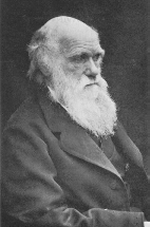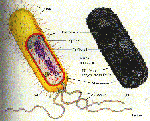
Evolution and Creationism: Chapter 3
Reviewing Genesis
Chapter 3 of Life -- How Did it Get Here? By Evolution or by Creation? is devoted to the Jehovah's Witnesses' interpretation of the creation account. This analysis is broken down into three parts:
- A definition of a "day" as used in Genesis.
- An interpretation of the six "days" of creation
- An attempt to validate the creation account scientifically.
Let's look at each of these sections individually.
The Length of a "Day"
The Jehovah's Witnesses use the "old-earth" creationist argument -- for them, the Hebrew word yohm, which is generally translated as "day" in Genesis 1-2 can be validly translated to mean a long (indeterminate) period of time.1 Thus, the earth can be many millenia old. What is not stated directly in this section, but which is implied by a literal reading of the story of Adam and Eve is that mankind is no older than 6,000 years (determined by counting up the "begats" and ages of Adam and his decendants).
The significance of the length of a "day" is that according to the "young-earth" creationists' view, the world can be no older than 6,000 years plus seven literal days and there are number of independant dating techniques which provide consistent measurements for the age of the earth, and which establish its age at 4.5 billion years.2
The Six "Days"
Basic interpretations of Genesis are provided in simple, scientific-sounding terminology.
- Day 1: Genesis 1:3-5
- Day 2: Genesis 1:6-8
- Day 3: Genesis 1:9-11
- Day 4: Genesis 1:14-16
- Day 5: Genesis 1:20-21
- Day 6: Genesis 1:24-27 and Genesis 2:5-9, 15-18, 21-22
This section concludes by suggesting that
[f]rom what we have considered, the Genesis creation account emerges as a scientifically sound document [...]3
But, as Alan Feuerbacher points out:
[...] up to this point chapter 3 has considered nothing that leads to this conclusion. The only things it has covered are descriptions of Genesis' creative days and certain obvious facts, i.e., light exists, night and day exist, there is dry land, the sun and moon can be seen in the sky, there are seasons and there are many forms of life.4
Scientific Validation
 Figure 1: Prokaryotes -- one-celled organisms
Figure 1: Prokaryotes -- one-celled organisms
What Life proposes as evidence of the creation account is a curiosity of probability: the book suggests that guessing the correct order of the 10 major creation events is so unlikely that it only stands to reason that God informed Moses of this order. Note, however, that this arguement is evidence for divinity, and not evidence for creation.
But are things as wildly improbable as Life suggests? Let's briefly assume that Moses did, indeed, correctly "guess" the items in the correct order. These ten items include:
- a beginning;
- a primitive earth in darkness and enshrouded in heavy gases and water;
- light;
- an expanse or atmosphere;
- large areas of dry land;
- land plants;
- sun, moon and stars discernible in the expanse, and seasons beginning;
- sea monsters and flying creatures;
- wild and tame beasts, mammals;
- man.5
Life argues that describing events in this order without outside influence is comparable to randomly selecting ten numbered blocks out of a box, and getting them in order: a 1 in 3,628,800 chance. Firstly, I submit that the two situations are not analagous, because there is clearly information in the list of 10 items that obviously suggest ordering. For example, item number one ("a beginning") must obviously come first. This immediately reduces the odds to 1 in 362,880. Similarly, "land plants" must logically come after "large areas of dry land".
Further, do we have reason to believe that Moses' account is actually correct? Life assumes that the Genesis account has been proven scientifically sound, although it has not. As Feuerbacher states:
The key point claimed is that science agrees that the stages of creation occurred in the general order stated in Genesis, and therefore God must have informed Moses of them. How does the writer show the order in which science says the stages occurred? He does not do so in the main text. However, in a side box not referenced in the main text [...] Life supports its key point with a quotation from a single geologist. It provides no geological data, and no references to geology texts or any other science reference material. From this one quotation and the list of ten cre- ation events, it draws the conclusion that there is next to no chance that the writer of Genesis just guessed the right order of creation. But is the key "fact" correct, i.e., is it really true that science agrees that the stages of creation occurred in the same general order as presented in Genesis?6
Feuerbacher argues that although science and Genesis agree that there is a beginning, they differ about the details.7 According to Big Bang theory, science can make no statement about what existed before the Big Bang, because the physics are not defined.
Further, with respect to what primitive earth was like:
Again science cannot say with any certainty. Many theories have been advanced, but almost all are acknowledged to be speculative because there is no conclusive evidence. [...T]he composition and evolution of the early atmosphere is poorly understood, as is the mode of formation of the oceans. What is agreed upon is that a solid surface existed before any oceans accumulated upon it. These things eliminate agreement with points (2), (3), (4), (5), and (7) above.8
Finally, with respect to life on earth:
The geological record of the rocks is much clearer on this than on the early history of the earth. Due to the scarcity of evidence, much is speculative about early one-celled forms of life, but there is a great deal of evidence regarding life after hard-shelled forms appeared. According to most geological source references, first came one-celled organisms called prokaryotes, which do not contain a nucleus. They appeared at first in the form of anaerobic bacteria, then in the form of photosynthetic bacteria, next aerobic bacteria, and finally blue-green algae. Next came one celled organisms called eukaryotes, which contain a nucleus. Finally came multicellular organisms in great variety.
The multicellular organisms were at first marine invertebrates of various types. Then fish and higher marine plants appeared. Next came land plants, amphibians, and insects. Next reptiles, then birds and mammals, and finally man. Note especially that science says fish came before land plants, and some land animals such as amphibians and scorpions came before any flying creatures, including flying insects. If Genesis were correct, whales in particular would have come before dinosaurs, and so would birds, because the simple pastoral Israelites would have understood "the great sea monsters" to include whales, and the "flying creatures" to include birds. The fossil record shows there were both swimming and flying dinosaurs that often were built along the same lines as their mammalian and avian counterparts. But this was unknown to the Israelites. These things show that (6) above is out of order, and (6), (8), and (9) are mixed up. The only thing that is entirely in agreement with science in the above list is that man came last.9
Science may be mistaken; we may discover some time from now that new evidence suggests that the Genesis account is in the correct order. That's not the point. What is significant is that Life has argued that there is scientific evidence of the correctness of a creationist interpretation of the Genesis account based on:
- mathematical probability and
- scientific agreement about the order of events.
Since there is no scientific agreement, the argument is unproven. The initial argument was also flawed, however, both because the use of mathematics was not correct, and because the argument was only evidence of divinity, not of creationism.
Closing Remarks
Two points seem particularly relevent in this chapter:
- On p.25, Life submits that the Genesis account is not
scientifically acurate from the point of view of an independant
observer. Rather,
it describes events as they would have been seen by human observers had they been present. This can be noted from its treatment of events on the fourth Genesis "day". There the sun and moon are described as great luminaries in comparison to the stars.10
What is clear from this is that the Bible is simplified for human understanding; what remains unclear is why, therefore, a literal interpretation of the Genesis account is necessary.
- The "well-known geologist" quoted in support of the order of
the ten creation events is Wallace Pratt, who believed
- that the earth was created in six literal days, thereby rejecting
scientific evidence about the age of the earth,
and - that he stated the quoted material at a lecture in 1928 (much has changed in the field of geology since 1928).
Regrettably, Life fails to mention these facts about their well-known geologist, because they weaken the overall argument.
- that the earth was created in six literal days, thereby rejecting
scientific evidence about the age of the earth,
1 Life -- How Did it Get Here? By Evolution or by Creation? p.26.
2 Chris Stassen. The talk.origins Archive's "The Age of the Earth"
3 Life p.35. Life does not offer its definition of "scientific document".
4 Alan M. Feuerbacher. The talk.origins Archive's "The Intellectual Dishonesty of Jehovah's Witnesses"
6 "The Intellectual Dishonesty of Jehovah's Witnesses"
7ibid.
8ibid.
9ibid.